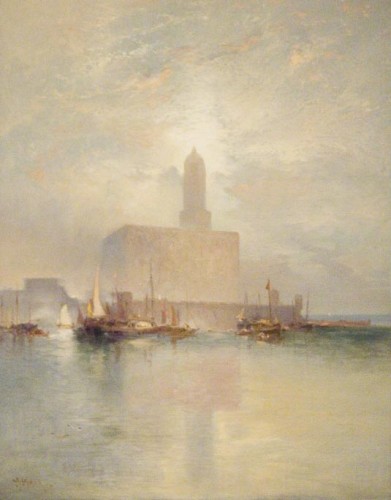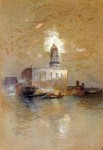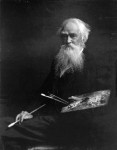

Thomas Moran
English, 1837-1926 (active USA)
Veracruz, 1885
oil on canvas
28 x 21 3/4 in.
SBMA, Gift of Mrs. Lockwood de Forest
1984.53.5

Photograph of Thomas Moran, 1921, courtesy East Hampton Library
"I place no value upon literal transcripts from nature. My general scope is not realistic; all my tendencies are toward idealization. Of course, all art must come through nature or naturalism, but I believe that a place, as a place, has no value in itself for the artist only so far as it furnishes the material from which to construct a picture." - Thomas Moran

Vera Cruz Harbor: 1884
COMMENTS
Thomas Moran was born 1837 in Bolton, England, the son of a hand-loom weaver whose life had been irrevocably changed by the advent of the Industrial Revolution. Displaced by laborsaving machinery, Thomas Moran Sr. immigrated to America. He settled his family in Kensington, Pennsylvania (near Philadelphia), in 1844.
Moran considered himself a self-taught artist. He began his artistic career as a teenage apprentice to the Philadelphia wood engraving firm Scattergood & Telfer. Moran found the engraving process "tedious" and spent his free time working on his own watercolors. He eventually became an illustrator for publications rather than a wood carver. During the 1870s and 1880s Moran's designs for wood-engraved illustrations appeared in major magazines and gift oriented publications.
Moran traveled to England in 1862 to see the artist J. M. W. Turner's work and he often acknowledged that artist's influence on his use of color and choice of landscapes.
Moran was married to Scottish born Mary Nimmo Moran (1842–1899), who was also an etcher and landscape painter.
By 1876 Moran had established himself as a leading landscape painter, rivaling German-born Bierstadt (1830-1902). The two artists competed for patronage and congressional favor for years. Bierstadt, whose romantic vistas took even greater liberties with reality than Moran’s, painted exclusively in oil; Moran, on the other hand, became a master of watercolor.
An indefatigable traveler, Moran and his family returned to Bolton, England, early in 1882, where the native son was celebrated in local newspapers. Ever the businessman, he mounted a sizable exhibition--including 22 oil paintings, 100 watercolors, a series of 25 illustrations from Longfellow's Hiawatha, a series of etchings and proof engravings, and the complete set of Prang chromolithographs of Yellowstone. Sales were apparently brisk, since a Boston newspaper later reported, "His paintings and etchings have been warmly commended by critics, and he has sold nearly all of them to eager purchasers." The true highlight of the European trip came later, after a side trip to Scotland, when Moran and his wife visited London and met John Ruskin, the eminent English critic, who purchased some of Moran's work. Winning approval from Turner's champion must have been a true high point of Moran's professional career.
Shortly after returning from England, Moran embarked on a trip to Cuba and Mexico. Tireless in his pursuit of new subject matter, Moran completed a large number of sketches, including several extraordinary views of the Trojes Mine in central Mexico as well as the harbor in Vera Cruz.
The painting Veracruz, 1885 in the SBMA collection is from this time period and looks much like a sketch dated a few years earlier entitled, Castle of San Juan D'Ulloa - Vera Cruz, Mexico: 1883. The composition and light are quite similar and you can see how the painting in our collection came about. Another finalized painting, Vera Cruz Harbor, 1884, from a year prior, has the same quality of light and paint as the one in the SBMA collection. However, this time the painting is in a traditional landscape format and views the harbor from the opposite direction.
Using sketches and photographs as memory aids, Moran gathered information that he would use--sometimes years later--to produce his studio paintings. Well into the twentieth century, Moran continued producing works that reflected his.
Blessed with energy and good health, Moran continued to travel and paint well into his 80s. He and his daughter Ruth spent many winters at El Tovar Hotel in the Grand Canyon, where the views inspired the small but panoramic A MIRACLE OF NATURE (1913), painted when Moran was 76.
During Thomas Moran’s long and prolific career he produced some of the most remarkable landscapes of the nineteenth century. When Moran died at his home in Santa Barbara, CA, in August 1926, just before his 90th birthday, he was hailed as “the dean of American landscape painters”. And, in the three decades since Moran had first visited Yellowstone, Congress had expanded the initial legislation setting aside additional "parks" including Yosemite in 1890. Inextricably linked through his paintings to numerous landscapes that eventually became national parks, Moran would one day also be known as the "father of the national park system.”
Prepared for the SBMA Docent Council by Loree Gold, 2012
http://hoocher.com/Thomas_Moran/Thomas_Moran.htm
Stephen May is a freelance writer in Washington, D.C., Reprinted courtesy Southwest Art, February 1998
Smithsonian American Art Museum
http://en.wikipedia.org/wiki/Thomas_Moran
